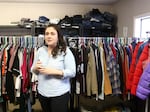Madysun Wilson had already given up on graduating when the dean at her high school showed up during her shift at Papa Murphy’s in Coos Bay, Oregon.
She was technically homeless, crashing at a friend’s house after leaving her family home at 15. Casey McCord, the dean, had been calling her relatives for weeks letting them know Wilson was on the verge of dropping out of Marshfield High School.
The next day, Wilson agreed to come to her school, where McCord marched her to the back of the building to introduce her to Melinda Torres. Torres is the employee tasked with connecting with and supporting homeless students in the Coos Bay School District.

Melinda Torres, Homeless Liaison and At Risk Kids Program Manager, speaks with Marshfield High School senior Alex Garcia Pascual at the ARK Center on the campus of Marshfield High School in Coos Bay, Oregon on Tuesday November 15, 2022.
Michael Sullivan / InvestigateWest
Torres urged Wilson not to drop out — offering that if she really didn’t want to finish her studies at Marshfield, the school could help pay for her General Equivalency Diploma (GED). They could also help her get clothes and food. It worked: Wilson passed her high-school-equivalency tests in December 2021 and now, at 17, is working toward an associate degree at Southwestern Oregon Community College. She dreams of working with homeless youth in the future.
“For the majority of my life, I didn’t think I was going to graduate high school,” Wilson said. But with help, she decided, “I wanted to (do) better. I want to get out of Coos Bay.”
In a way, Wilson was lucky to attend Marshfield, where staff at her school kept track of her living situation and pushed her to complete her GED. Many schools across Oregon are far less successful in identifying homeless students and connecting them with food, shelter and academic support, an InvestigateWest analysis found.
Federal law requires every district across the country to provide students experiencing homelessness full access to school and extracurriculars. But first, those students need to be identified — and at least 16 Oregon school districts with more than 20 students enrolled failed to identify a single homeless student during the 2019-20 school year, federal education data shows.
No homeless students might sound like good news, but experts say it reflects schools’ inability to identify homeless youth rather than actual levels of poverty and homelessness in their communities.
“If you’re a tiny, rural district with 11 students, yeah, sure,” said Barbara Duffield, executive director of SchoolHouse Connection, a national nonprofit focused on improving outcomes for homeless youth. “But otherwise, you’re not going to have a district that has no student experiencing homelessness, especially year after year.”
Additionally, data analysis by InvestigateWest and the Center for Public Integrity suggests at least 21% of Oregon districts are under-identifying the number of homeless students attending their schools.
The problem of undercounting is not unique to the Beaver State. Public Integrity’s analysis estimates that, nationwide, as many as 300,000 homeless students might be going uncounted each year. Black, Latino and Native Alaskan and American Indian youth were overrepresented in the homeless student population.
Failing to identify homeless students isn’t simply a matter of bureaucratic bookkeeping. It can mean the difference between a student accessing free school meals or going hungry; getting to participate in athletics or missing out; or receiving help with transportation to school or being dropped, particularly in Oregon, where the law requires schools to unenroll students after 10 consecutive days of unexcused absences.
In Wilson’s case, she believes her story would be quite different without the intervention by her school.
“Honestly, I could see myself still working at that Papa Murphy’s, doing nothing,” she said. “Thank goodness Melinda plugged me in.”
Data reveals disparities
In the late 1980s, homelessness was rapidly rising in the United States, and women and children were making up an increasing share of the unhoused population.
So in 1986, Congress passed the Homeless Persons’ Survival Act, which was later renamed the McKinney-Vento Homeless Assistance Act. It included a broad range of emergency measures and long-term interventions. One of those was a requirement that schools ensure homeless students had access to the same educational opportunities as their non-homeless peers.
That work begins with identification of students, which is why the law requires districts to report their numbers of students each year. State departments of education, meanwhile, are tasked with providing professional development opportunities for school districts and enforcing their compliance with the law.
Some research suggests that an accurate or even conservative estimate of homelessness in a student body should wind up totaling at least 5% of students who qualify for free and reduced lunch. The Florida Department of Education has even incorporated that as a statewide benchmark to ensure schools are not missing students.
In Oregon, dozens of districts fell below that benchmark in the school years preceding the pandemic, data from the 2018-2019 and 2019-2020 school years show.
In 2018-19, 37 Oregon school districts counted less than 5% of their free and reduced lunch populations as homeless. That number ticked up the following year, to 42 districts, including the Salem-Keizer School District with 41,200 students and Wallowa School District with 181 students.

Southwestern Oregon Community College freshman Madysun Wilson spends time in her dormitory room at the Coos Bay, Oregon school on Tuesday November 15, 2022.
Michael Sullivan / Michael Sullivan
In fact, the number of districts potentially undercounting their homeless students could be higher, because Public Integrity’s dataset omitted charter schools, which, in Oregon, means about 30 school districts are excluded from the analysis. Another 24 school districts that did not report reliable data on their free and reduced lunch population were also not included in the analysis.
Oregon Department of Education officials said they don’t use a benchmark to assess whether districts are accurately counting their homeless students. Chris James, the department’s senior strategic adviser for homeless and vulnerable youth, said he views the state’s approach as collaborative rather than punitive. Oregon education officials did not provide any examples of the state challenging a district’s data or the fact it reported no homeless students.
“In my experience, it is not to be the heavy hand of enforcement, as much as helping them,” James said of the state’s approach to the issue.
The U.S. Department of Education, which has oversight of the states, described a similar approach. States where school districts fail to follow the law are subject to increased monitoring, but the federal agency would not tell Public Integrity how often that happens.
A spokesman said only that the agency “engages in monitoring and compliance activities that can include investigating alleged non-compliance.”
Advocates, though, said accountability from the state and federal department of education can be critical to ensuring students don’t go uncounted.
“If a district doesn’t think there are any consequences for not identifying students — for not transporting them, not enrolling them — they’ll just keep doing it,” said Duffield, the executive director of SchoolHouse Connection.
About a dozen school districts reported zero homeless students in both 2018-2019 and 2019-2020. The majority of those schools serve extremely rural areas or small towns, largely in Eastern Oregon. All have fewer than 1,000 students.
Grant School District 3 in Grant County, which had a student population of 594 in 2019-2020, reported no homeless students both that year and the previous year, though 50.8% of its students qualified for free or reduced lunch.
“It’s frustrating for me to not know,” said Catrina Gabbard, the district’s homeless liaison since 2016. Under the McKinney-Vento law, each district is required to designate at least one staff member as a homeless liaison who is responsible for connecting students with resources, reporting data and training other staff on the law so they can assist with identification.
Larger school districts may have more than one person designated as homeless liaisons. But as is common in many smaller districts, Gabbard wears multiple hats: She is also an administrative assistant at an elementary school.
Gabbard attributed most of her difficulty identifying students to stigma. In one instance, she learned that a student was homeless only after they left the district and later returned. They had never told any school staff or even informed their extended family members while it was happening, she said.
“I don’t know what to do. It is a hard thing to tackle,” Gabbard said.
Research has shown that rural students experience homelessness at rates roughly equivalent to those in urban communities. And the definition of homelessness in education is broader than that used by the Department of Housing and Urban Development.

Melinda Torres, Homeless Liaison and At Risk Kids Program Manager, discusses the clothing items available to children in need at the ARK Center on the campus of Marshfield High School in Coos Bay, Oregon on Tuesday November 15, 2022.
Michael Sullivan / Michael Sullivan
“I would definitely be very suspicious of a number of school districts in a county saying zero students are experiencing homelessness,” said Marisa Zapata, director of the Homelessness Research and Action Collaborative, a research center at Portland State University.
Liz Ross, director of federal systems for the Oregon Department of Education, said in an email that the department “reviews data for outliers, trends and patterns, size of district, as well as extenuating circumstances (such as natural disasters) prior to determining if outreach is necessary.”
Not all rural communities appear to undercount homeless students. Elsewhere in Eastern Oregon, the tiny Long Creek School District had identified several students as homeless among its population, despite being a tenth of the size of Grant School District 3. About half of its 39 students qualify for free and reduced lunch, and the district reported just over 7% of all students experienced homelessness in 2019-20.
Jennifer Garinger is the homelessness coordinator for the district, the deputy clerk and the office manager. She said her multifaceted roles and her family’s connections in the town all help ensure that students don’t slip through the cracks. One son-in-law is assistant fire chief and drives a school bus, and another is the youth pastor and a coach.
“It’s just Long Creek culture,” Garinger said. “What works here is the kids and the families just know they can ask (for help).”
Still, she said, certain aspects of small-town life can also impede the identification of homeless students.
It’s not uncommon for families to live in multigenerational households or to move into a trailer on someone else’s property, she said. Both of those situations could qualify a student for McKinney-Vento services, but they’re not the kind of “traditional homelessness” residents might think of, Garinger said.
Often, “by the time (students are) counted, they’re housed,” she said.
Effective partnerships remain rare
Mary Ferrell knows the challenges of effectively supporting students experiencing homelessness from within school walls.
She did it for several years in the Medford School District in Southern Oregon as a homeless liaison before launching a new venture: a nonprofit that works adjacent to the schools in the region to support the work of identifying and assisting homeless students and their families.
That was in 2009. Now, 13 years later, the Maslow Project has relationships with seven school districts and manages the McKinney-Vento subgrants awarded to four of them. The students they serve are typically identified by their schools’ liaisons and then are connected with Maslow Project caseworkers who help them and their families with everything from clothing to academic support to temporary and permanent shelter.
“The nice and unique thing about Maslow is we are able to leverage … the funding we get through individual donations and grants to pair up with the school funding that we manage,” Ferrell said. “We’re able to make that money go further because of the type of nonprofit we are.”
None of the districts included in Public Integrity’s dataset that Maslow works with fell below the 5% of free and reduced lunch threshold, suggesting the collaborative outreach approach is bearing fruit in identifying students.
The students who work with Maslow also graduate at higher rates than in other parts of Oregon: In 2021, 88% of the students connected with Maslow graduated, compared with 60.5% of homeless students across the state, according to the nonprofit.
Torres, the McKinney-Vento liaison in Coos Bay, was inspired by a Maslow training she attended. After learning about the project’s drop-in center where students could find clothing, food and other essential resources, Torres decided to try to re-create the center in her district.
Today, Coos Bay community members who are up to 21 years old and their families can visit the ARK Project at Marshfield High School, which Torres runs for the school district. The site offers laundry access, food and hygiene products, clothing, and school supplies.
“We also help with getting birth certificates, permits, licenses, GED testing prep,” Torres said.
Bowie Rae Sekne moved to Coos Bay shortly after his 18th birthday and now receives support from the ARK Project. Housing disruption is not new to him: Throughout his childhood, he said, family issues frequently led him and his siblings to spend nights in hotels or at their grandmother’s house.
No one at his school ever identified him for McKinney-Vento services.
“I didn’t get as much support that I really needed,” Sekne said.
Torres has helped him secure copies of his birth certificate and Social Security card, and together they’re working to get Sekne his learner’s permit to drive. For the first time in a long time, he’s excited about his future.
“Especially with homeless youth,” Sekne said, “it’s really hard to have the tools you need to work on school stuff.”
Other times, Torres’ work involves more broadly circulating information about what rights students experiencing homelessness have. They are entitled to retain enrollment in their school of origin even if they move out of the district, for example, and the district is required to help with transportation if needed.
Torres also has formed partnerships with other community organizations. She works closely with Alternative Youth Activities, a nonprofit that supports the education of students dealing with housing instability. It was Alternative Youth Activities that helped Wilson study for her GED, for example.
Despite the success of such community partnerships, they remain relatively sparse in other parts of Oregon.
In some cases, Ferrell said, “There may be fears around lines of authority, control of limited resources, or fears of being replaced.”
New money, no silver bullet
In 2021, Congress included $800 million in the American Rescue Plan to help schools serve homeless students.
Of that, $7.4 million came to Oregon schools.
That comes on top of less than $900,000 Oregon receives in federal funding tied to the McKinney-Vento law — dollars that are exclusively doled out through competitive grants.
A greater number of school districts in Oregon were able to access that Rescue Plan money, and they could spend it more freely than McKinney-Vento funds.
Klamath Falls City Schools, for example, budgeted $13,500 to assist two students with housing over three years, records show. North Marion School District budgeted nearly $6,000 in prepaid debit cards and gift cards to help students purchase materials “necessary for students to participate fully in school activities,” such as shoes, clothing and uniforms.
“That was honestly kind of a miracle, a unicorn pot of dollars that gave us flexibility we have not ever had with school funding before,” Ferrell said of the American Rescue Plan funds.
In April, 92 members of the U.S. House of Representatives signed a “Dear Colleague” letter, urging the leadership of the House Education Committee to renew the $800 million in funding, which represents 1% of the federal education budget, for the fiscal year that started Oct. 1.

Southwestern Oregon Community College freshman Madysun Wilson works on her laptop in her dormitory room at the Coos Bay, Oregon school on Tuesday November 15, 2022.
Michael Sullivan / InvestigateWest
“Investing in a young person’s life will enable them to avoid chronic homelessness, intergenerational cycles of poverty, and pervasive instances of trauma,” the letter read.
Budget bills from both chambers of Congress requested increases to the program budget, but they are far less than the renewal the House members requested. Federal budget negotiations are expected to resume in December.
Duffield said increasing support for homeless students is a key component to improving their outcomes.
But other pieces are needed, too, she said. One is accountability — districts need to know their state is being vigilant about compliance with the law.
“Policymakers at the state and federal level are ultimately the ones who have the power to change this,” she said. “They can appropriate more dollars, they can require more oversight.”
Duffield also called for greater awareness about youth homelessness, and the kinds of obstacles students face when they are dealing with housing instability.
Often, she said, “these students aren’t visible because they are dealing with so much trauma.”
This article was produced in partnership with the Center for Public Integrity, The Seattle Times, Street Sense Media and WAMU/DCist.